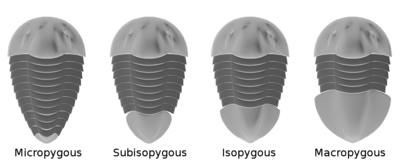Pygidium

Thepygidium(pl.:pygidia) is the posterior body part or shield ofcrustaceansand some otherarthropods,such asinsectsand the extincttrilobites.In groups other than insects, it contains theanusand, in females, theovipositor.It is composed of fused body segments, sometimes with a tail, and separated fromthoracicsegments by an articulation.[1]
Chelicerates
[edit]Inarachnids,the pygidium is formed by reduction of the last three opisthosomal segments to rings where there is no distinction between tergites and sternites. A pygidium is present inPalpigradi,Amblypygi,Uropygi,Schizomida,Ricinuleiand in the extinct orderTrigonotarbida.It is also present in early fossil representatives ofhorseshoe crabs.
Trilobites
[edit]In trilobites, the pygidium can range from extremely small (much smaller than the head, orcephalon) to larger than the cephalon. They can be smooth, as in orderAsaphida,or spiny, as in orderLichida.They can be classified into four categories according to their relative size in comparison to the cephalon.[2]
- Micropygous– the pygidium is considerably smaller than the cephalon.
- Subisopygous– the pygidium is slightly smaller than the cephalon.
- Isopygous– the cephalon and the pygidium are more or less of equal size.
- Macropygous– the pygidium is larger than the cephalon.
They can further be subdivided in their morphological similarity to thethorax.Pygidia that are similar in shape and form to the thoracic segments are termedhomonomous,while pygidia that vary significantly from the shape and form of the thoracic segments (like by the presence or absence of spines) areheteronomous.

Insects
[edit]In insects, the pygidium is the dorsaltergiteof the last external abdominal segment.[3]
Other uses
[edit]Pygidiumis also a supersededgenusoffishof thefamilyTrichomycteridae.Most species of this genus have been reassigned to the genusTrichomycterus.
See also
[edit]References
[edit]- ^Shultz, J.W. (1990). Evolutionary Morphology And Phylogeny of Arachnida. Cladistics 6: 1–38.
- ^Samuel M. Gon III (November 12, 2009)."The Pygidium".A Guide to the Orders of Trilobites.RetrievedApril 13,2011.
- ^G. Gordh, D. Headrick. 2003.A Dictionary of Entomology.CABI Publishing. p. 757.


